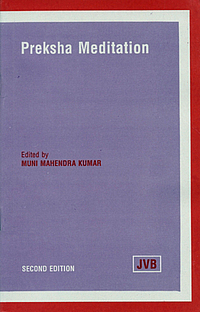 | About: |
| Peace! Peace!! Peace!!!
Everyone is in search of peace. In the individual and family life as well as social and international relations, peace is the ultimate goal. In Indian philosophy, the ultimate aim of soul is moksa (emancipation) or nirvana.
Another word for this is shanti (peace). That is, the ultimate aim of soul is Peace. Peace, therefore, is undoubtedly the highest good and the total good. Mental peace is the case of an individual and world peace in the international affairs are eternal goals for man and the mankind.
Attainment of peace is possible only if the mental disturbance is absent. In a turbulent mind, or an agitated person, peace cannot prevail. Thus, the key to peace lies in overcoming all mental fluctuations, or in other words, complete concentration of mind.
Now, concentration of mind can be of two kinds:- (a) Concentration on a thought or an idea, (b) Concentration on "perception" or "seeing".
The Preksha Meditation is "concentration on perception."
The word preksha is derived from the rout 'iksa' which means 'to see\ When the prefix 'pra' is added, it becomes pra+iksa=preksa, which means "to perceive carefully and profoundly."
Here 'seeing' does not mean external vision, but careful concentration on subtle consciousness by mental insight. Preksa-dhyana is the system of meditation engaging one's mind fully in the perception of subtle internal and innate phenomena of consciousness.
'Samplkkhae appagamappaenam' (Skt. Samprekseta atmanamatmana), - the aphorism from the Jaina canon Dasavealiyam, forms the basic principle for this system of meditation. It simply means: "See you thyself" - "perceive and realise the most subtle aspects of consciousness by your conscious mind." Hence 'to see' is the fundamental principle of meditation. The name preksa-dhyana was therefore assigned to this system. Thus this technique is basically not concentration of 'thought', but concentration of 'perception'.
The term dhyana (meditation) is usually defined as the 'concentration of thinking on a particular subject for a length of time'. Now, the mind is the instrument of 'thinking' as well as 'perception'. And, therefore, when linked with 'preksa', 'dhyana' becomes 'concentration of perception' and not of 'thought'. Perceiving which is an important aspect of human mind is generally underestimated. Most of us give importance only to such mental faculties as thinking, intellectual analysis, logical or rational conception, but rarely try to develop the faculty of "perceiving". Now, fortunately, scientists also have recognised the value of perceptive meditation. In the words of Fritj of Capra, the author of the famous book The Tao of Physics, "the firm basis of knowledge on experience in Eastern mysticism suggests a parallel to the firm basis of scientific knowledge on experiment. This parallel is further enforced by the nature of the mystical experience. It is described in the Eastern traditions as a direct insight which lies outside the realm of the intellect and is obtained by watching rather than thinking; by looking inside oneself; by observation", (p. 22, Bantam, Rev. Edition, 1984).
In preksa, perception always means experience bereft of the duality of like and dislike. When the experience is contaminated with pleasure or pain, like and dislike, perception loses its primary position.
| |
| Author: | Muni Mahendra Kumar |
| Publisher: | Jain Vishwa Bharati, Ladnun, India |
| Editor: | Muni Mahendra Kumar |
| Translator: | |
| Edition: | Second Edition, 1994 |
| Read online: | |
| Bookshop: | Preksha Meditation |
| Pages: | 27 |
| Dimensions: | 14.00 x 17.70 x 0.20 cm (W x H x D) |
| Weight: | 47 g |